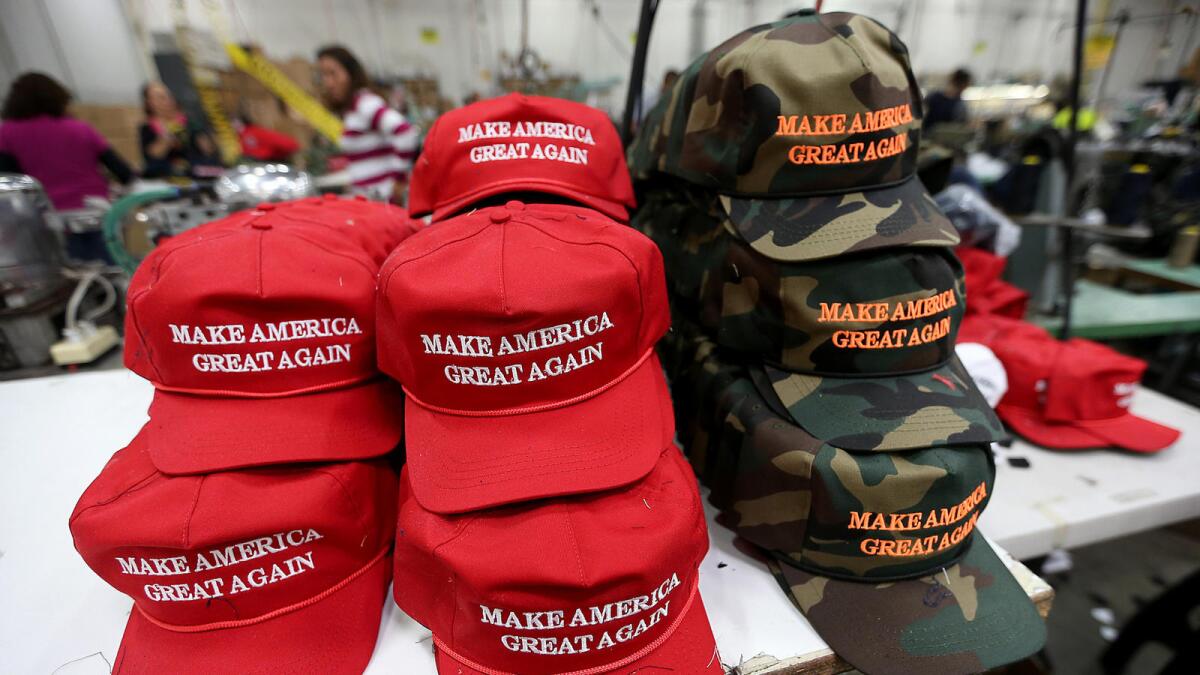I went to a UCLA seminar on triggering — and was triggered by a MAGA hat

- Share via
I circle around UCLA’s Moore Hall for the third time. Security officers block each entrance. Police in riot gear patrol the streets. Metal fences wall off the building from protesters, and barricades separate protesters on the left from those on the right. Everyone prepares for Donald Trump Jr.’s arrival to promote his new book, “Triggered: How the Left Thrives on Hate and Wants to Silence Us.”
As a trauma therapist who works with women and refugees — and who practices on Canada’s west coast — I admit that I live in a progressive bubble. I’ve never met a Trump supporter in the flesh and the psychiatrist in me is curious: What puzzle pieces of life experience could come together to produce a world-view so opposite to mine? I hope to chat with a Trump voter to try to understand.
But then I see my first MAGA hat.
My mind floods with images of climate activist Greta Thunberg crying “How dare you?” and white men marching in straight-pride parades, wielding swastikas, guns and Confederate flags. I envision immigrant children warehoused in cages and online comments that scream, “Go back to where you came from.”
I tense up and glare at the man in MAGA. I want him to feel unwelcome, unsafe and, mostly, to feel shame.
I’m at UCLA to attend a psychotherapy course to learn about these kind of moments — when big emotions short circuit our mind’s higher functions so we can’t think or behave skillfully. The professor playfully called it “boom time.” In other words, we’re triggered.
To mental health professionals, “triggered” describes intense, involuntary emotional and physical reactions linked to past traumatic experiences. We often use the concept more broadly to help people identify triggers — whether traumatic or not — that set off unwanted emotions, physical reactions and behaviors.
In his book, Trump Jr. borrows the term “triggered” to describe getting offended or one’s feelings hurt. Rather than an unwanted, involuntary physiological reaction, he sees it as a tool intentionally used to silence the right.
When our minds are functioning well, we’re able to reflect on our thoughts and feelings so we can make sense of our own internal world and reactions and have empathy for the inner experiences and behaviors of others.
Problems arise when stressful experiences cause our emotions to overheat, deactivating the areas of our brain that allow us to take in new information and reflect on it. We fry our abilities to think and behave skillfully. It’s boom time and our mind’s offline.
Stressful experiences can also cause us to freeze, shut down or devalue emotions, preventing our feelings from fueling action. This may help us survive immediate danger, but ongoing disengagement leaves us numb and immobile, unable to change our circumstances.
So the MAGA hat triggers in me a slideshow of sorrow and shock from today’s volatile and divisive world, and I’m no longer capable of being curious or compassionate for all the experiences that make this man who he is: a human (like me) desperately trying to belong and survive, who (like me) is socialized by complex forces outside of his awareness and control, and who (like me) may feel fear, grief, powerlessness or shame hiding under his armor of anger.
Instead I slip into a false refuge of certainty. I know this guy — he’s a fascist, racist, misogynistic, homophobe.
In this state — rather than reflecting, acknowledging uncertainty and responding effectively — we react in fight, flight or freeze. We know we’re right, stick to our story and take immediate action to prove it.
When we observe undesirable behavior in others, we too often reflexively tell them off and shame them with the message “I’m right and you’re an idiot,” the title of a 2016 book by James Hoggan on the state of today’s public discourse. We push them into boom time.
We cannot debate rationally with someone in boom time — the wall goes up and it’s impossible to let anything in. Regardless, we are all on the same team, confronted by shared problems that require cooperation. After years of researching what makes a team thrive, Google discovered the key ingredient is psychological safety.
In this way, antiracist educator Robin DiAngelo disarms her audiences by changing the narrative from “you are racist and only bad people are racist,” which leads to shame, defensiveness and shutting down, to “racism is a system into which we are all socialized,” which allows us to feel safe enough to receive constructive feedback and change.
With our public square spiraling into a combat zone, the only beliefs we seem to share is that we all think we’re the ones who are right. I didn’t get a chance to communicate with the Trump supporter. Boom time sidelined me.
It may have sidelined Trump Jr. too. He left the stage early during the UCLA event last fall after members of a far-right group kept disrupting his talk.
Next time it may be the left attacking the right, or the right attacking the left.
Do we really want to live in a society where we need to be separated by metal fences and riot police to attend a book launch?
The source of the problem isn’t rogue individuals being triggered, as Trump Jr. argues, but a vicious culture that is triggering. As we become more divided, the more we attack each other, the more we are left unable to truly see each other as complex human beings and have empathy for each other’s needs and struggles.
When most everyone is being triggered, no one can listen.
Joanna Cheek is a psychiatrist and clinical assistant professor of medicine at the University of British Columbia.
More to Read
A cure for the common opinion
Get thought-provoking perspectives with our weekly newsletter.
You may occasionally receive promotional content from the Los Angeles Times.






